Strawberry fields forever!
Well, not forever. But certainly for a good long way.

Cats, charts, and politics

Strawberry fields forever!
Well, not forever. But certainly for a good long way.

Via David Leonhardt at the New York Times, here's the rate of new COVID-19 cases by county:
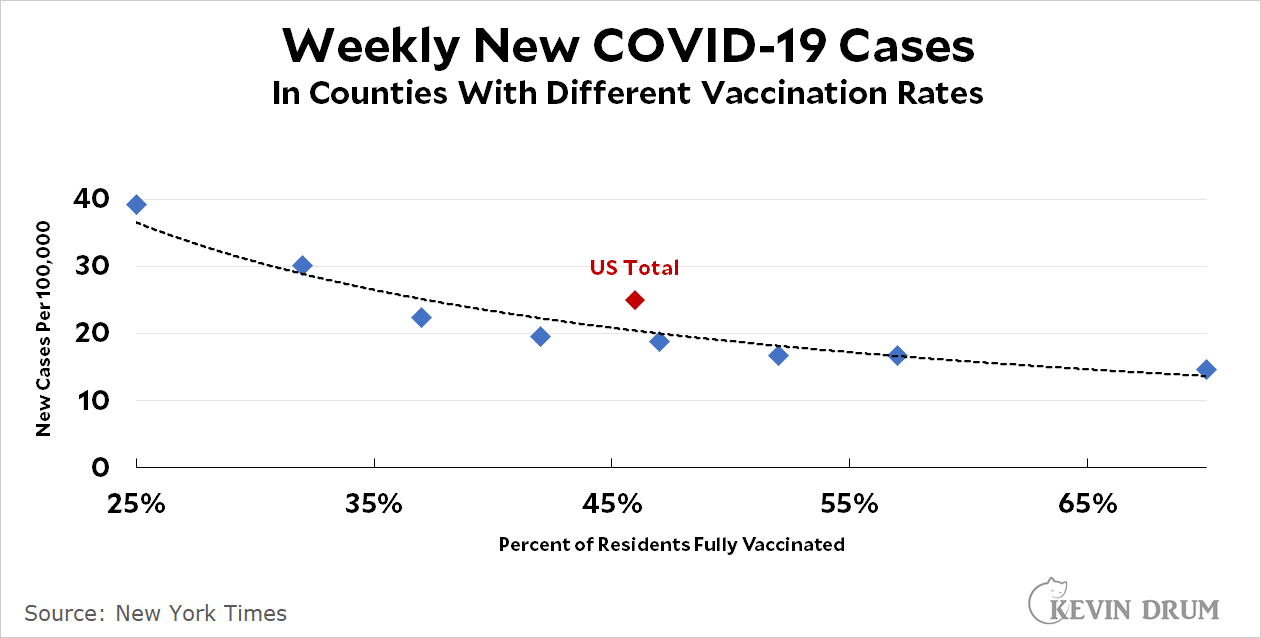
We could be crushing COVID-19 completely. We have the technology. The main thing stopping us is vaccine skepticism, primarily among conservatives, which conservative politicians and conservative media refuse to do anything about. The contempt they're showing for their own constituents is almost beyond belief.
Here’s the officially reported coronavirus death toll through June 27. The raw data from Johns Hopkins is here.
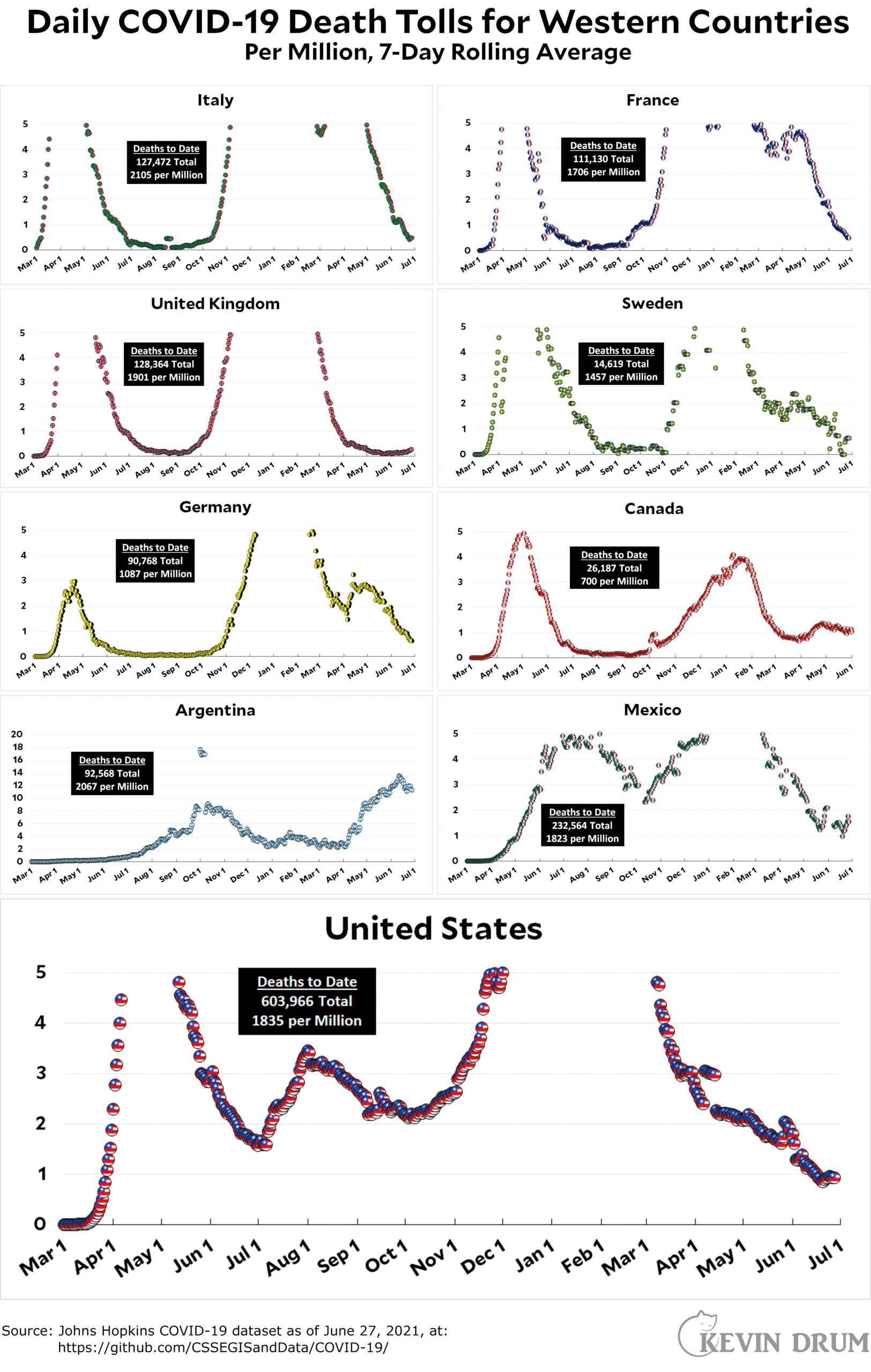
Over at Vox there's a piece today headlined "Why does it cost so much to build things in America?" It's about the sky-high cost of transportation construction projects in the United States, and it gives me an excuse to post the chart below:
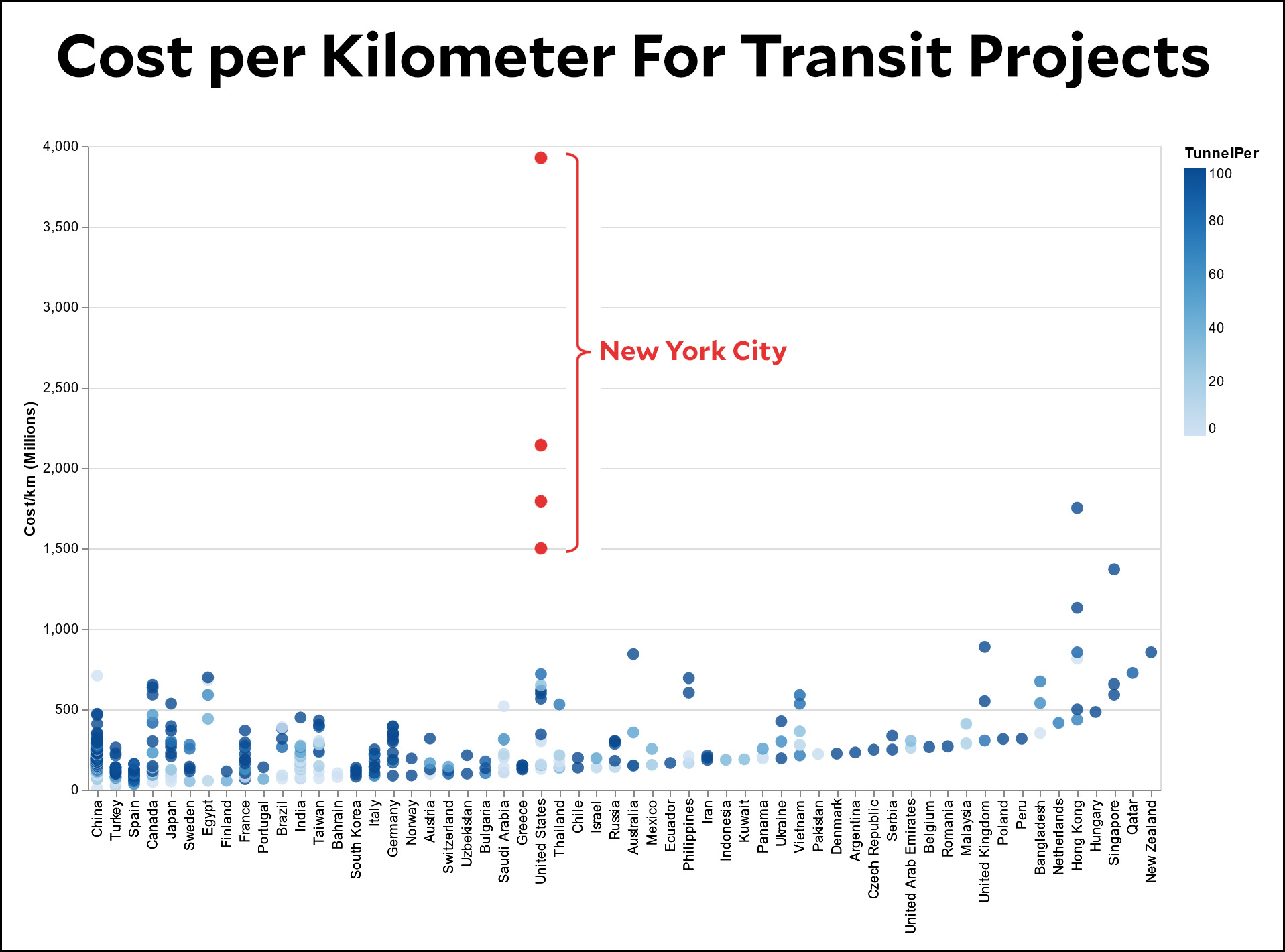
As you can see, New York City truly has sky-high construction costs for transit projects. But the rest of the country is fairly normal. We're higher than some countries and lower than others, probably coming in at a bit over average.
This disparity is so obvious that I think any comparison of transit construction costs should treat the United States as two separate regions: New York City and everyplace else.
As for ordinary highway construction costs, that's more difficult to get a handle on. However, based on several different estimates and studies, it doesn't appear that the US (ex NYC) has higher costs per kilometer than comparable projects in Europe.
In other words, I suspect that all future versions of this article should be headlined "Why does it cost so much to build things in New York City?"
Expanded unemployment benefits are fully funded through September, but some states have cut them off already in hopes of getting more people back into the workforce. Does this work?
On Sunday, both the Wall Street Journal and the New York Times tried to answer this question. By chance, both of them chose to focus on the state of Missouri. Here's the Journal:
Americans Are Leaving Unemployment Rolls More Quickly in States Cutting Off Benefits
The number of unemployment-benefit recipients is falling at a faster rate in Missouri and 21 other states canceling enhanced and extended payments this month, suggesting that ending the aid could push more people to take jobs.
....Midas Hospitality, a St. Louis-based hotel company with 44 locations around the U.S., started holding job fairs to increase staffing as coronavirus restrictions eased about two months ago....“It’s crazy how quickly” things seem to be ramping up, she said, noting that workers in other states where Midas operates and the federal benefits are still in place appear reluctant to re-enter the workforce.
Spectacular! But here's the Times:
Where Jobless Benefits Were Cut, Jobs Are Still Hard to Fill
By lunchtime, the representatives from the recruiting agency Express Employment Professionals decided to pack up and leave the job fair in the St. Louis suburb of Maryland Heights. Hardly anyone had shown up....Work-force development officials said they had seen virtually no uptick in applicants since the governor’s announcement, which ended a $300 weekly supplement to other benefits. And the online job site Indeed found that in states that have abandoned the federal benefits, clicks on job postings were below the national average.
Both papers used anecdotes and data. And in both papers, the anecdotes matched the data. The Journal says workers are practically fighting over jobs, while the Times says workers are nothing short of disgusted by the crappy jobs on offer.
So which is it? Your guess is as good as mine.
Here’s the officially reported coronavirus death toll through June 26. The raw data from Johns Hopkins is here.
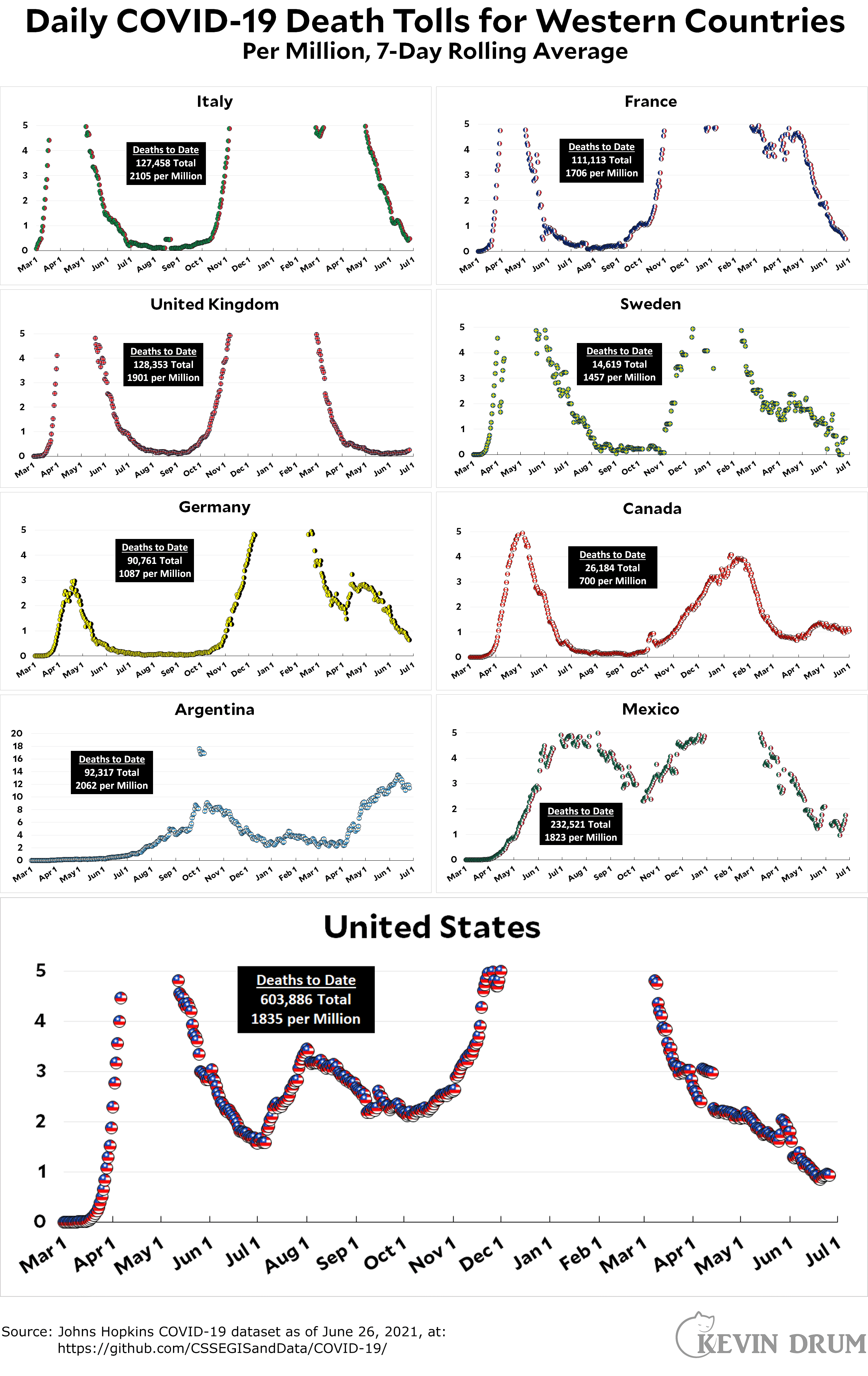
Bob Somerby is discussing Karin Chenoweth's new book, Districts That Succeed, which suggests, among other things, that Chicago has made substantial progress in its schools over the past couple of decades. As usual, that got me curious: has Chicago made a lot of progress? The quickest reference point is their performance on the NAEP test, so let's take a look:

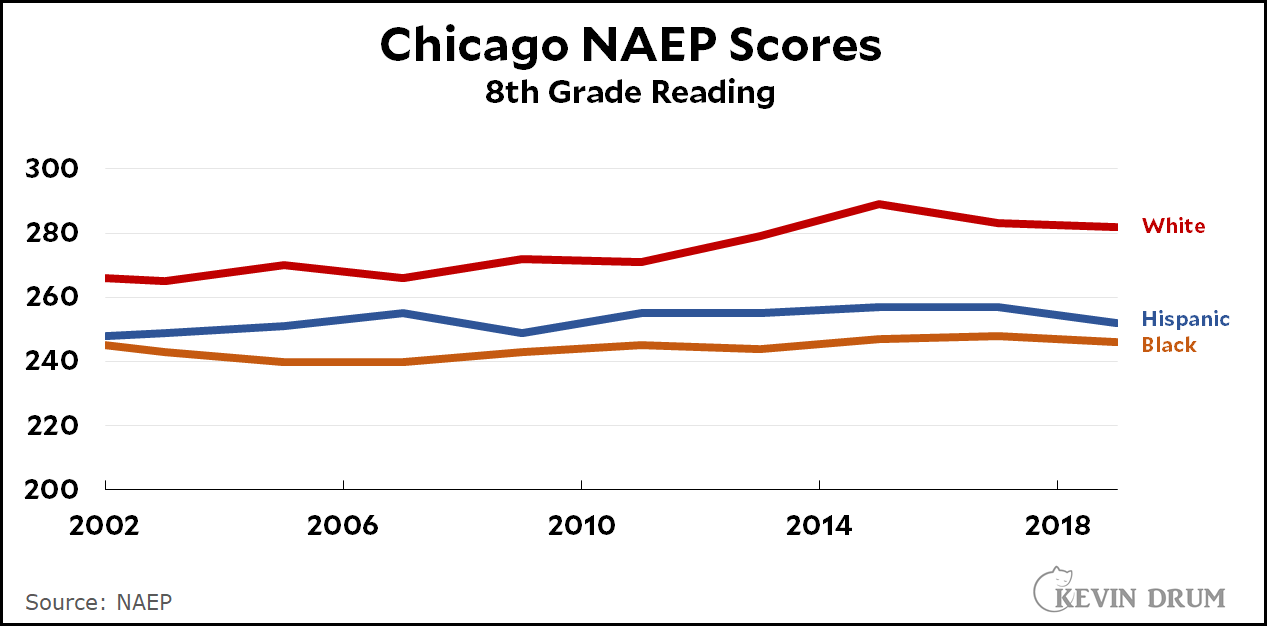
The top chart is for reading at the 8th grade level, and it shows that Chicago performs at about the same level as big cities nationwide. There's nothing especially wrong with that, but it hasn't changed a bit since 2002.
The bottom chart breaks out 8th grade reading scores by race. Hispanic scores have gone up slightly since 2002 and Black scores have made no progress at all. The only change is that Chicago's small cadre of white 8th graders made an 18-point gain between 2011 and 2015 and have mostly maintained it since then.
It's unusual to see such a big gain, roughly equivalent to two grade levels, over the course of only four years. It gets my spidey sense tingling. Nonetheless, even if it's legit it's the only progress Chicago has made. It's been average among big cities for two decades, and neither Hispanic nor Black children, which make up virtually the entire district, have improved more than a tiny bit. If this is success, we sure have lowered the bar lately.
POSTSCRIPT: Everyone has made progress in math over the past couple of decades, and so has Chicago. It has caught up to the big-city average, and all racial groups have improved. However, white students have improved quite a bit more than either Black or Hispanic students.
I generally focus on reading because reading scores are more indicative of success in the real world. I also generally try to focus on 12th graders, but NAEP's TUDA program for large cities doesn't include district level data above 8th grade.
Nothing new to report on the multiple myeloma front this month:
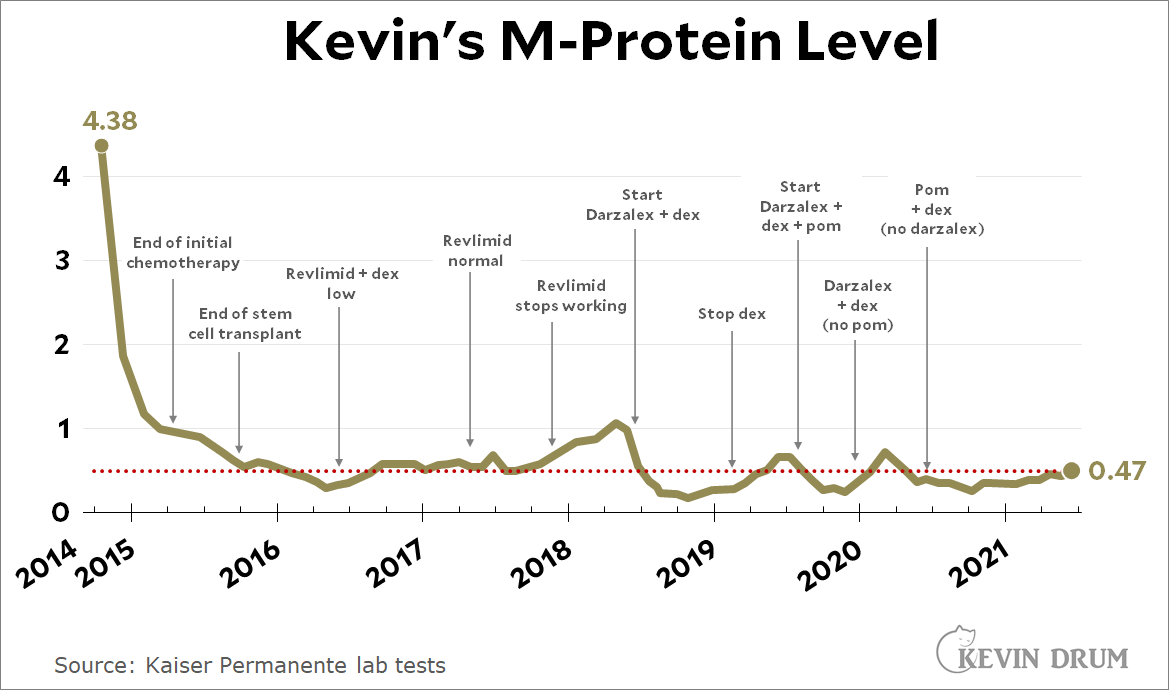
Over the last three months my M-protein level has been 0.46, 0.44, and now 0.47. In other words, completely flat, meaning the cancer is under control. No news is good news.
The Johns Hopkins dataset already has a new record (empty for now) that's set up for "2020 Olympic Games." I can't blame them, of course, but it's kind of discouraging to see.
Here’s the officially reported coronavirus death toll through June 25. The raw data from Johns Hopkins is here.

Today the Pentagon released its long-awaited report on UAPs (Unidentified Aerial Phenomena). Click here if you feel like reading it—it's only four pages long. Basically, the report says that nobody has any idea what's going on, which is honest but not especially satisfying. It also doesn't really leave any scope for comment from the hot take industry.
However, I will comment on this, from the Washington Post's reporting:
“I was first briefed on these unidentified aerial phenomena nearly three years ago,” said Sen. Mark R. Warner (D-Va.), the chairman of the Senate Intelligence Committee. “Since then, the frequency of these incidents only appears to be increasing. The United States must be able to understand and mitigate threats to our pilots, whether they’re from drones or weather balloons or adversary intelligence capabilities.”
....Sen. Marco Rubio (R-Fla.), the ranking member of the intelligence committee, said...“This report is an important first step in cataloging these incidents, but it is just a first step. The Defense Department and Intelligence Community have a lot of work to do before we can actually understand whether these aerial threats present a serious national security concern.”
The report says that UAPs could be a national security problem if they "represent sophisticated collection against U.S. military activities by a foreign government or demonstrate a breakthrough aerospace technology by a potential adversary." But come on. I know it's fashionable to trash talk US intelligence these days, but it's not that incompetent. A lot of the stuff that gets reported by pilots would require technology light years ahead of our own on a whole bunch of different levels (stealth, propulsion, avionics, etc.). Hell, some of it would probably require anti-gravity. Human technology is by far the least likely explanation for any of it.
This poses a question. Do Warner and Rubio really believe what they're saying? Or is this going to become the latest Team B nonsense designed to justify ever higher defense spending? I'm just asking questions here.